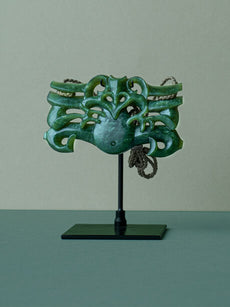Your cart is empty
Keep ShoppingCustomary uses and meanings of the Hei Tiki
Traditional Māori personal adornments take a wide variety of forms, and although all are greatly treasured, the Hei Tiki is most esteemed and highly prized.
Thought to represent the human form, Hei Tiki are a complex form, and one of the most challenging to shape by hand, with New Zealand pounamu typically being used for their creation. The form is deemed to be one of the highest achievements of early pounamu artistry and today's jade carvers take great care in protecting the culturally iconic figure in their work.
As a multifaceted taonga (treasure), many customary uses and meanings belong to the Hei Tiki, and in this blog, we will explore some of the purposes it embodies.

Meaning of Hei Tiki
When you break the word down into its separate parts, "Hei" donates something worn around the neck and "Tiki" is a word used by Māori for human images carved into wood, bone, stone, or other material.
A Hei Tiki is therefore an image carved in human form that is worn around the neck.

Some believe that Tiki was the first man in Māori legend, created by the atua (God or supernatural being) Tāne. Others consider Tiki to be the atua himself and the forefather of humankind. Whether man or God, there is consensus in Māori culture that humankind descends from Tiki lineage.
A legend of Hei Tiki
One legend tells of Ngahue (the ancestor like God) fleeing from tropical Hawaiki (traditional Māori place of origin) with his coveted pounamu fish Poutini. They were chased away by Hine-tū-a-hōanga and her abrasive cutting stone Whaiapu. They arrived in Tuhua (Mayor Island) in the Bay of Plenty, but sensing their foe close by, they continued to the beautiful Arahura River in Te Waipounamu - New Zealand's South Island. Here Ngaue deposits Poutini into the river as an eternal resting place for his precious stone. Ngahue then returned to Hawaiki with a portion of pounamu taken from the side of the fish and worked upon the stone to fashion the first Hei Tiki adornment.
With time, Hawaiki became a mythical origin for everything good and powerful in the Māori worldview. With the origin attributions of the Hei Tiki and pounamu to Hawaiki, it is understandable why they are highly regarded cultural treasures.

Adorning a Hei Tiki
For different reasons, Hei Tiki have long been adorned by Māori. Some wear Hei Tiki to remember revered tūpuna (ancestors) who once possessed them. Others wear it as tohu rangatira (symbols of chiefly rank).
Hine-te-iwaiwa, the deity of child birth and all womanly tasks, was the goddness credited with owning the first Hei Tiki. For this reason, women are also known to wear Hei Tiki as a talisman of fertility and easy childbirth.
Many also believe that when worn Hei Tiki can act as a kaitiaki (guardian), protecting the wearer in times of peril.
Over time, as each generation has adorned the Hei Tiki, and as korero (stories) are told, the prestige of the form has grown.


Passing on a Hei Tiki
Great care is taken to protect Hei Tiki and pass the taonga from one generation to the next. As heirloom treasures, Hei Tiki are thought to form lasting connections with tūpuna (ancestors) and convey their memory and spiritual presence. Some also believe that the pounamu stone soaks in the mana (power and prestige) of the ancestors who wore the Hei Tiki before, providing protection and guardianship to the new wearer.

Here are some of our artists latest Hei Tiki Designs. Explore our full collection of Hei Tiki here.
New Zealand Pounamu Large Tiki with Paua Eyes
$3480.00

New Zealand Jade Dark Green Hei Tiki with Paua Eyes
$2280.00

New Zealand Flower Jade Large Tiki Necklace
$2798.00

SHOP ALL HEI TIKI
-

The significance of Māori ocean lore and the hei matau
The ocean is deeply rooted in Māori worldview and culture and thought by many as the foundation of all life. Protected by the gods, it is a source of food and...
-

Māori weaponry and the Mere Pounamu
From a young age, Māori warriors would begin training for combat so they could build up the strength and skills to serve their tribe. Conflict between tribes was commonplace, and...























Follow Us
Stay in the know on new releases, special offers, and more.